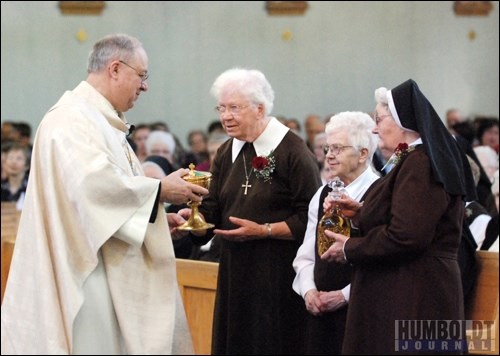One hundred years ago, on May 14, 1911, a trio of Austrian nuns stood on the lonely platform of the Muenster railway station in the early afternoon of another windblown West-Central Saskatchewan day, waiting for a greeting that never materialized.
A mix-up had caused their telegram from Winnipeg to be late, so no one in the fledgling communities of Humboldt and Muenster knew they were already here. They had experienced a hard 15-day journey from Klagenfurt, Austria, by train through Bavaria and Prussia, by ship to America, and by rail again up into Canada, which was to be their new home. They were exhausted, but undaunted. They were not the type to complain.
So, with no ride in sight, acting Superior Sr. Augustina Platzer, Sr. Philomena Jug and Sr. Gabriela Lex, and their chaperone, Fr. George Trunk, picked up their valises and trudged toward the Benedictine monastery.
Their arrival might have been overlooked. But in the 100 years since, their presence in those communities has never been forgotten. Their legacy remains with us to this day.
Grateful residents of the Humboldt area came out in large numbers on Sunday, May 15 for a mass and banquet commemorating the 100th anniversary of the arrival of the three sisters of the Order of St. Elizabeth. The celebrations took place at St. Augustine Church. Among those sharing in the days' events were 18 fellow sisters of the Order, who travelled to Humboldt from Austria, Germany, Slovakia, and the Czech Republic. Accompanying them was a priest from Poland.
Presiding over the morning mass was Abbot Peter Novecosky, OSB, of St. Peter's Abbey. He noted it was a real honour to pay homage to the good deeds of those three sisters, and to the many others who followed in their footsteps. Many of those Abbot Peter has counted as personal friends.
"Their presence here has meant a lot to the community over the years, in terms of health care and all the other (areas) that they've been involved in," he told the Humboldt Journal. "It's a good occasion to give thanks to them."
Abbot Peter said it would be hard to imagine what Humboldt would be like had those three sisters not initially chosen to settle here, and to begin their good works in serving their fellow beings. One of their first orders of business was to set up a hospital in cooperation with the town. The first Humboldt hospital was built under their supervision in 1912.
"They came at a time when there were few resources available, and they really put themselves out there to be of service to the sick and those who needed care," Abbot Peter said. "But they also initiated a lot of new things, too I know that they have been in leadership positions not just with the hospital, but in the community as a whole."
In subsequent years, and as more of their numbers arrived to join them in Canada, the sisters also provided nurses' training. From its inception in 1923 to its closure in 1969, their school of nursing in Humboldt graduated 472 students. Many of those were also on hand on Sunday, to give thanks.
But the sisters' good works extended well beyond health care, Abbot Peter stressed.
"At St. Peter's Abbey and St. Peter's College they were involved in kitchen work, they sewed a lot of clothing for us (the Benedictine monks) over the years, and for the Oblate community in Battleford and the Franciscan community in Lumsden. And they certainly were involved in home care. They pitched in, often without any financial repayment. We really owe them a lot."
In his address to the St. Augustine congregation, Abbot Peter noted that the sisters' numbers are dwindling.
"I suspect there are more buried in the cemetery than are here today with us," he said.
As the sect has aged, and its numbers dwindled, he noted that the legacy of the sisters has not diminished, and remains a beacon for others to follow. Their example has touched the lives of all citizens of the region, religious or otherwise.
"They're not as young as they used to be, and they're not as numerous as they used to be, either," he noted. "And so as they age, I think their role has certainly changed, being more of a 'presence' than being active on the frontline. Their work has been handed on to other people, and that's been happening across other areas of our societies as well. As the religious draw back and get older, the laypeople are taking over a lot of that work. So I think we have a lot to be thankful for in terms of their pioneering work, and their pioneering spirit, and for setting an example for others to follow.
"It's important to remember their legacy," he added. "When we grew up, we had sisters among us and we saw them at their work. The younger generation is not seeing them working as such. But I think the younger generation is being called to service, perhaps of a different kind
"I think it's good for them to know and to remember both the history and the people who started a lot of this stuff, and on whose shoulders we are standing. And I think it's a source of inspiration for them as well, for the younger generation."




